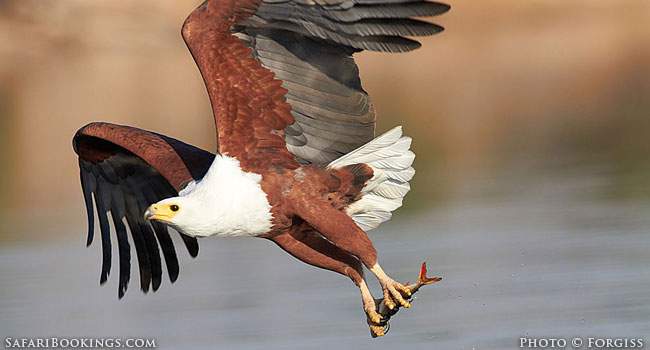

The African Fish Eagle pairs up whether it is in or out of mating season, which goes from March to September. When the male fish eagle nears the nest it makes a kind of mellow ‘quock’ sound where as the female has a more of a shriller sound. There are two specific calls, the one is in flight and the other is when it is perched. The beautiful and distinct call of the African Fish Eagle is synonymous with the sound of Africa and is very similar to the American Bald Eagle. The nest is built usually near water at the fork of a tree, sometimes on a cliff ledge or on a steep slope on a low slope. The African Fish Eagle makes its nest out of large piles of sticks, 30 to 60 cm deep and 120 to 180 cm in diameter.

They can also be found near estuaries and coastal lagoons but are rarely spotted in the southwestern parts of Africa and areas on the eastern part of Somalia because the land is so arid. The Fish Eagles habitat is limited to mainly lakes, large rivers, pans and dams with surrounding trees for it to perch on. The length of the African Fish Eagle varies between 63 and 75 cm. This fairly large bird is related to the North American Bald Eagle and can be easily identified by the distinct black, brown body and white head and tail. This includes the River eagle, Aigle pecheur, Pygargue vocifer, Afrikaanse visarend and so on. Information from the Kruger National Park site.The African Fish Eagle or as it is scientifically known, Haliaeetus vocifer, can be seen throughout Southern Africa and is known by many varieties of names, in many languages. It is particularly common in and around some of the Rift Valley lakes. Some tend to move around to avoid the wettest weather, whereas others stay where they are all year round. Near a lake with an abundant food supply, a pair may require less than a square mile of water to find enough food, whereas next to a small river, they may require a stretch of 15 miles or more. It is most frequently seen sitting high in a tall tree from where it has a good view of the stretch of river, lakeshore or coastline, which is its territory. They spend more time perched than flying, and usually settle for the day by 10am, having made their kill, although they will kill at any time of the day. The African Fish Eagle is usually seen in pairs inside and outside the breeding season, even sharing kills made by either of them. So well known and clear is the call of this bird that it is often known as ‘the voice of Africa’. When near the nest its call is more of a ‘quock’ sound – the female is a little shriller and less mellow than the male. In flight or perched, the sound is something like the American Bald Eagle. The African Fish Eagle has two distinct calls. Larger prey are eaten on the ground next to the water. Catfish and lungfish are caught most frequently. Their main diet is fish, sometimes dead, but mostly caught live. Goliath Herons are known to lose a percentage of their catch to Fish Eagles.

It is also known to eat carrion and is classified as a kleptoparasite (it steals prey from other birds).

It has a distinctive black, brown, and white plumage.Īlthough, as its name suggests, it feeds extensively on fish, in some areas it preys on flamingoes and other water birds. The African Fish Eagle is a fairly large eagle.


 0 kommentar(er)
0 kommentar(er)
